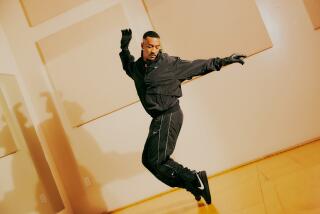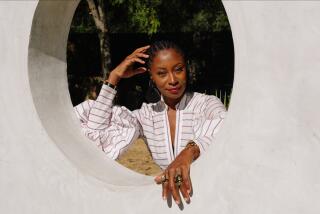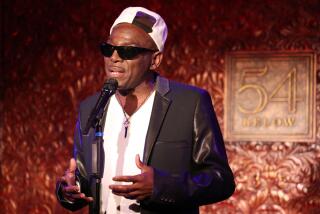Merce Cunningham company dances to the end
Reporting from New York —
It has been an extended and unprecedented countdown for the dancers and staff of the Merce Cunningham Dance Company. Never before has a modern-dance troupe planned for its own demise. But then Cunningham, one of the singular innovators in his field, who remained forward-looking and boldly creative until his 2009 death at age 90 — was always taking the lead, pioneering inventive, unexpected approaches.
The intensive two-year world tour culminates this week with six Events at Manhattan’s Park Avenue Armory.
The performances were planned by Cunningham as a global celebration and farewell. The armory, with its 55,000-square-foot drill hall, was his choice for his company’s final performance in its home city, and he stipulated the $10 ticket price. The dancing will unfold on three stages and, true to form, will feature newly commissioned music and original décor by Daniel Arsham.
“These two years seemed like a gift. But now that we’re in the last stretch, there’s constant adrenaline — we’re tired but so excited,” said Andrea Weber, a member of the company of 14 dancers for nearly eight years. “About two months ago we started saying goodbye to theaters, people. During the past week, we’ve done four pieces for the last time. It hasn’t quite hit me yet, that it’s the last time dancing them.”
The tour has included 150 performances since February 2010. The pace — as well as the emotional intensity — increased this year, when the company performed in 15 states plus Washington, D.C., and Hong Kong, Israel, France, England, Mexico, Germany and Russia.
The dancers’ commitment and galvanizing focus were evident this month during three final repertory programs at the Brooklyn Academy of Music before heading to Paris — a city where Cunningham’s work was especially beloved — for eight performances. BAM’s packed houses, with many former company members in attendance, greeted each program with roaring ovations and numerous curtain calls.
Silas Riener, who joined in 2007, said, “The last 10 months have been bonkers — the touring and performing pace. Because the work is so difficult physically, to add that level of emotion makes it a psychological struggle. The company has really rallied in an incredible way. We all made the decision to stay, and we’re all completely dedicated to the work,” he said by phone just before the company departed for Paris.
The Cunningham Dance Foundation (which sustains the activities of the company, school, archives and more) announced the Legacy Plan in June 2009, when Cunningham had just turned 90. He celebrated that milestone with a new full-evening work cheekily titled “Nearly Ninety.” He had beamed happily from his wheelchair during the bows at its BAM premiere. Though declining physically, he always continued to teach and choreograph. It turned out that the plan would be set in motion soon afterward, when he died on July 26.
Without the company as primary exponent of Cunningham’s work, new venues and situations are expected to sustain its import. All assets of the Cunningham Dance Foundation will be transferred to the Merce Cunningham Trust, which will manage the choreographer’s artistic legacy, licensing his works to companies and educational institutions and partnering in special projects, performances and exhibitions. A major focus is the preparation of “Dance Capsules” for 88 Cunningham works — digital packages with video and complete documentation of each dance.
As Trevor Carlson, executive director of the Cunningham Dance Foundation, explained by phone, the formation of the trust led to discussion about the future.
“There is no role model for us to follow,” he said. “The examples that exist are nowhere close to what we’ve had to do — in the midst of a worldwide financial crisis. We’re very proud of where we stand today, what we have accomplished.”
An $8-million capital campaign in support of the Legacy Plan is nearly complete, Carlson reported, with about $100,000 more needed to reach the goal.
“Planning a formal closure and a known end date has allowed everyone to celebrate, come together,” he said. “So there’s sadness, but also it’s an opportunity to be clear about what is happening. The tour is a way of saying thank you and goodbye.”
Cunningham’s headquarters in the Westbeth artists’ complex in Greenwich Village, the company’s home since the 1970s, will close at the end of March. It has long been a mecca for dancers eager to study Cunningham’s physically and intellectually demanding technique. Classes will continue in New York at City Center, where the trust will maintain an office, and former company members will be teaching elsewhere.
Robert Swinston, who joined the company in 1980 and became Cunningham’s assistant and director of choreography while still performing, will have an ongoing role, overseeing the classes. A crucial mainstay as the company moved through its transition, he staged many revivals for the tour and for the feisty Repertory Understudy Group, which gave additional Cunningham dances new life. At its fascinating final performances last month at the studio, it the Understudy Group danced six works dating from 1958 to 1989.
Former dancer Patricia Lent will continue as director of licensing.
“We’ve seen an enormous increase in the number of companies licensing Merce’s work,” Carlson said. “Repertory companies are stepping forward with interest in making it something regularly programmed.”
One such company is Benjamin Millepied’s new L.A. Dance Project. Cunningham’s “Winterbranch” will be on the L.A. Dance Project’s debut program at Walt Disney Concert Hall in September. The dance will be staged by current MCDC dancer Jennifer Goggans with coaching by Swinston.
Company dancer Riener noted that “a lot of people from the company are going out, carrying the torch for Merce’s work. There are possibilities for his work in the future.” But he acknowledges that nothing can replace the intense experience of those who were present while Cunningham experimented with movement possibilities as he created dances. “This regimen is likely not something anyone will ever want to do again.”
The company’s final performance on New Year’s Eve will mark the end of a radical and visionary era in dance — and open up an unforeseen future for the Cunningham technique and repertory, and for the dancers themselves. Weber, who has plans to teach and hopes to continue performing, said: “After doing Merce’s work it’s going to be important to still have challenges. I think we’re all drawn to that somehow. The work says it all. I’m intrigued to see what I can find, what will happen.”
More to Read
The biggest entertainment stories
Get our big stories about Hollywood, film, television, music, arts, culture and more right in your inbox as soon as they publish.
You may occasionally receive promotional content from the Los Angeles Times.






